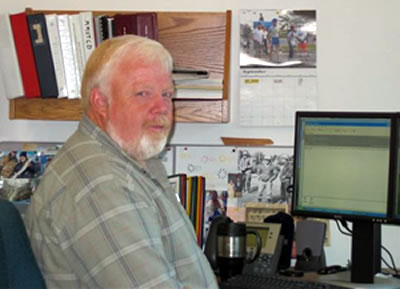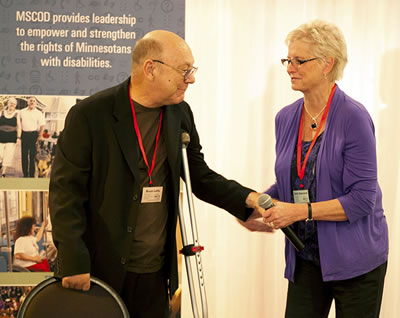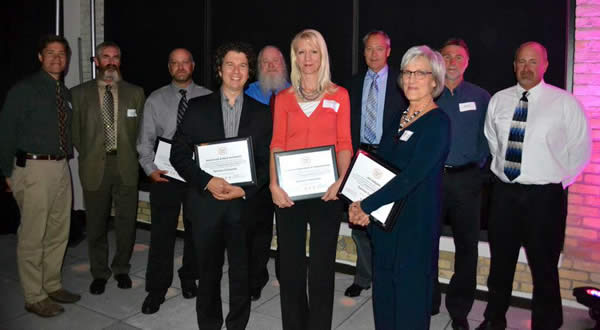 |
|

|
 |
TABLE of CONTENTS
 |
Charlie Zelle to become MnDOT commissioner Jan. 15 |

Charlie Zelle, president and CEO of Jefferson Lines, will become MnDOT's next commissioner beginning Jan. 15. File photo |
Gov. Mark Dayton Dec. 12 appointed Charlie Zelle as Minnesota’s next transportation commissioner. Zelle, president and CEO of Jefferson Lines, a Minneapolis-based transportation company, will begin his work at MnDOT Jan. 15.
He succeeds Commissioner Tom Sorel, who resigned Dec. 1 to become the CEO of AAA Minneapolis.
“Charlie Zelle’s outstanding record of innovation in the private sector will serve Minnesota well as we build a transportation system that will serve our needs and support our future growth and prosperity,” said Dayton. “I know that Mr. Zelle’s very successful business career and his strong commitment to public service will make him an outstanding commissioner of MnDOT at this important time.”
In addition to his professional work at Jefferson Lines, Zelle has volunteered his time on transportation policy and business issues in a variety of capacities. Zelle currently serves as the chair of the Minneapolis Regional Chamber of Commerce, and is a member of both the Corridors of Opportunity Policy Board and the Minnesota Chamber of Commerce Board of Directors. Earlier this year, Zelle was appointed by the governor to the Transportation Finance Advisory Committee, whose recommendations were announced earlier this month (see article in this issue of Newsline).
As a founding member of the Itasca Project, Zelle is co-chair of the group’s Transportation Task Force. He is also a Board Member and Chair of the Policy Committee of the American Bus Association in Washington, D.C. Zelle has served on the Executive Committee of the University of Minnesota Center for Transportation Studies and chaired the American Bus Association.
"It is a great honor to join the Dayton Administration in an area that is critically important to all Minnesotans,” said Zelle. “MnDOT has a strong reputation for innovation and I look forward to helping lead the agency as it plays an increasingly important role in advancing the state's future prosperity through key investments in infrastructure."
Zelle received the George Rucker Award from the Community Transportation Association in 2009 and the Ray L. Lappegaard Distinguished Service Award by CTS in 2012.
Governor’s news release
Zelle becomes 18th Minnesota transportation commissioner
Come Jan. 15 when he walks through MnDOT’s doors for the first time as transportation commissioner, Charlie Zelle will join the ranks of 17 others who have served in a similar capacity since 1917.
Nine commissioners led the Minnesota Highway Department, which was created in 1917. Eight others have served as commissioner for MnDOT, created in 1976 to take a multimodal perspective in meeting the state’s growing transportation needs. The new agency was formed by combining the former Department of Highways, the Department of Aeronautics and parts of the State Planning Agency and the Department of Public Service.
See dot.state.mn.us/library/commissioners.html for a list of former transportation commissioners. |
|
 |
|

|
 |
TABLE of CONTENTS
 |
Committee releases recommendations for statewide transportation needs during next 20 years |
The state transportation finance advisory committee Nov. 30 released its recommendations on transportation revenue and spending to Gov. Mark Dayton for consideration in his 2014-15 biennial budget.
In its summary report, TFAC provides recommendations that support an environment in which Minnesota businesses can continue to grow, ensure that the state continues to be an attractive location for companies looking to expand and position Minnesota well into the future. The funding and financing recommendations offer revenue-generating options for roads, transit, local government and projects.
“The committee has worked extremely hard on these recommendations,” said Acting MnDOT Commissioner Bernie Arseneau, who serves as the TFAC chair. “The group is made up of finance experts, government officials with a focus on transportation, business representatives and transportation advocates. The process drew on the group’s combined expertise to develop recommendations on ways to identify and fund transportation needs well into the future. It was a strong collaborative effort focused on what would best serve the state’s transportation needs for the next 20 years.”
In addition to helping Minnesota compete economically for jobs and talent, the committee envisions a world-class transportation system that enhances quality of life by connecting people to what matters – jobs, education, healthcare and more.
Bernie Arseneau, acting MnDOT commissioner
|
The committee began meeting in early 2012, receiving briefings about the state’s transportation system needs and funding process, and hearing concerns from citizens, local government, labor and industry, and transportation advocacy groups.
“In addition to helping Minnesota compete economically for jobs and talent, the committee envisions a world-class transportation system that enhances quality of life by connecting people to what matters – jobs, education, healthcare and more,” said Arseneau.
The recommendations and background on the committee’s work are available on the TFAC website at www.dot.state.mn.us/tfac/. A detailed report on the TFAC effort will be released later in December. |
 |
|

|
 |
TABLE of CONTENTS
 |
Delivering results: Two years toward a Better Minnesota |
A number of transportation-related accomplishments were highlighted in a news release that Gov. Mark Dayton issued Dec.19 that reported on progress the state has made during the past two years toward the administration’s “Building a Better Minnesota” effort.
One crucial measure for the Better Minnesota effort is providing sustainable options to safely move people, goods, services and information. Among the notable efforts MnDOT has contributed towards the mobility goal are:
- Making roads more durable. Invested $357 million in a four-year project to restore 700 miles of highway surface, employing 3,400 workers; 2012 saw the biggest pavement restoration program in Minnesota history.
- Removing stoplights and reducing congestion. Completed construction on Hwy 169/I-494 interchange, significantly reducing congestion and saving $35 million by using six ramps instead of eight.
- Stabilizing funding for roads, bridges and transit. Convened a panel of experts to explore new options for funding Minnesota’s aging transportation infrastructure; recommendations under consideration.
- Rebuilding the Hastings Bridge. Floated a new bridge downstream on a barge and successfully lifted it into position above the Mississippi River.
- Building a bridge safely and quickly. Used new strategies to build and move two 1,300-ton bridge spans over I-35E at Maryland Avenue, reducing road closures by two months and creating a safer work zone for motorists.
- Building public-private partnerships to fund crucial projects. Leveraged $103 million in private investment to fund 14 road projects statewide, including a new interchange on Hwy 10 in Perham that will boost local businesses and create 240 jobs.
For more information, see Building a Better Minnesota: Mobility. |
 |
|

|
 |
TABLE of CONTENTS
 |
Ribbon-cutting marks completion of Hwy 169/I-494 interchange construction |

Metro District Engineer Scott McBride (at lectern), other MnDOT staff and local partners celebrated the completion of the Hwy169/ Interstate 494 interchange project Nov. 29. The project, designed to reflect traffic demand, reconstructed all of Hwy 169 in the interchange area and installed flyover bridges, loops and ramps, and six roundabouts.
The performance-based design includes six ramps instead of eight (based on studies showing traffic from the west was minimal), removes stoplights and reduces congestion while meeting the needs of commuters. The $125 million project saved about $20 million compared to constructing it using the traditional approach. See the project website for more detail: www.dot.state.mn.us/metro/projects/169/. Photo by David Gonzalez |
|
 |
|

|
 |
TABLE of CONTENTS
 |
Tools of the trade: snowplows, salt. . .and social media |

Social media is the latest tool in MnDOT’s snowfighting arsenal. As the number of people who use social media continues to grow, MnDOT is using infographics, like the one pictured here, to remind motorists of safety tips for winter driving.
“We continue to send out news releases with weather alerts and road conditions,” said Kevin Gutknecht, Communications director, “but we’re adding simple graphics and short messages that go out through Facebook and Twitter so that more people receive information that will keep them safe.”
To see other infographics on snow and ice, visit MnDOT’s Facebook page at www.facebook.com/mndot. Infographic designed by Adam Peterson |
|
 |
|

|
 |
TABLE of CONTENTS
 |
Bemidji’s Keith Pence dies unexpectedly |
|
By Karen Bedeau, District 2 public affairs coordinator

Keith W. Pence, senior engineering specialist for District 2/Bemidji State Aid, died unexpectedly Dec. 1. Photo by Lou Tasa |
Keith W. Pence, senior engineering specialist for District 2/Bemidji State Aid, died unexpectedly Dec. 1. Pence was in the hospital recovering from knee surgery that had been performed two days earlier when he died. Tests are being conducted to determine the exact cause of his death.
“Keith was a dedicated and dependable employee,” said Lou Tasa, District 2/Bemidji state aid engineer. “In his current position in State Aid, Keith gained the respect of all the District 2 local agency engineers and their staff, MnDOT State Aid staff in CO, the other district state aid assistants, and developed friendships with them as well.
“Keith and I roomed together for nearly eight years and 10 months in the district state aid office,” Tasa said. “We shared many stories, enjoyed many similar interests and values, and had a great friendship. I will miss him very much and will never forget him as a friend and co-worker.”
Pence graduated from Walker High School in 1973 and received a degree as a survey technician from Wadena Technical School. He began his MnDOT career as a laborer in 1976, advancing through the highway technician series to his promotion as an engineering specialist. He was promoted to senior engineering specialist in 2003, and accepted the assignment to the district state aid office a few months later.
Pence is survived by his wife Donna Snobl Pence, District 2/Bemidji Planning; daughters Anna and Rachel; four brothers and two sisters; as well as many nieces and nephews.
“Keith was dedicated to his family and would make the time to help others when it was needed,” Tasa said. “He also made it a priority to watch all of his daughter’s high school basketball, volleyball and softball games.”
Pence’s funeral was held Dec. 8 in Bemidji. |
 |
|

|
 |
TABLE of CONTENTS
 |
Next book discussion scheduled for Jan. 9 |

Eric Davis will lead the next Commissioner's Reading Corner discussion on Jan. 9. Photo by Qin Tang |
Eric Davis, chief risk officer, will lead the discussion of Our Iceberg Is Melting: Changing and Succeeding Under Any Conditions by John Kotter on Jan. 9, from 1:30 to 2:30 pm.
Employees can participate virtually via Adobe Connect and should log in as a guest no earlier than 1:15 p.m. All employees are encouraged to attend, even if they have not yet read the book.
Read the interview Marilee Tuite, assistant librarian, did with Davis to learn, among other things, what he sees are the most important things readers can take away from this book that can be applied to their work or life.
For more information on the Commissioner’s Reading Corner, visit ihub/readingcorner or contact Qin Tang, MnDOT librarian, at 651-366-3784. |
 |
|

|
|

|
|

|
 |
TABLE of CONTENTS
 |
Bruce Lattu receives Minnesota State Council on Disability award |
By Jessica Wiens

Bruce Lattu receives the Minnesota Award from Barbara Stensland, MSCOD Council vice chair. Photo courtesy of MSCOD |
Bruce Lattu, MnDOT disabilities program coordinator, received the Minnesota Award from the Minnesota State Council on Disability.
The Minnesota Award is MSCOD’s highest honor to a Minnesotan with a disability who has worked to enhance the empowerment and employment of individuals with disabilities.
“I felt humbled and surprised,” said Lattu. “A lot of people have done really great work to help those that are disabled with workplace issues, and they all deserve recognition.”
Beyond overseeing more than 200 reasonable accommodations for MnDOT employees, Lattu also is most proud of being a driving force for MnDOT to fully commit to updating infrastructure and services to comply with the Title II component of the Americans with Disabilities Act. These include accessible highway crossings, signals, snow removal, public meetings, websites and electronic documents, among other areas.
Throughout his career, Lattu has worked to ensure that MnDOT and other state agencies are aware of not only the minimum requirements of the law, but also why it is right and good to go beyond those basic levels.
“Bruce broke new ground in the breadth of MnDOT’s ADA work for employees and the public,” said Lynnette Geschwind, Affirmation Action Office director. “He delivers the information people need to hear with compassion and kindness, yet he is a fierce advocate.”
Lattu also has worked recently on a Central Corridor Light Rail project committee to address accessibility issues specific to that project.
Editor’s note:
Bruce Lattu continues to be on medical leave of absence. He sends sincere gratitude to the people at MnDOT and other agencies who donated their vacation time to him and to other state employees so that they can focus on their health. |
|
 |
|

|
 |
TABLE of CONTENTS
 |
Historic restoration projects receive recognition |
By Becky Dahlberg

Historic Garrison Concourse project award recipients, from left to right: Ed Lutgen, Bridge; John Mackner and Tony Hughes, District 3; Todd Grover, MacDonald Mack Architects; Joe Cameron, District 3; Kristen Zschomler, Cultural Resources; Larry Rice, EAI; Kathryn McFadden, Site Development Unit, Historic Properties; Bill Kack and Ray Stenglein, EAI. |
Two historic restoration projects—the Garrison Concourse on the shores of Lake Mille Lacs and the Pierre Bottineau House in Maple Grove—were recently honored for MnDOT’s efforts to restore and preserve a part of the state’s history.

The Historic Garrison Concourse along Highway 169 on the shores of Lake Mille Lacs was originally constructed in 1936 by the Civilian Conservation Corps. File photo |
The Preservation Alliance of Minnesota recognized the work done to restore the historic Garrison Concourse, located in District 3 along Hwy 169 on the shores of Lake Mille Lacs. Specialty masons restored the historic stone masonry wall at the concourse, which is not only one of the largest historic walls in the department’s inventory of historic roadside properties, but is the only roadside structure that juts out into a body of water.
Kathryn McFadden, Site Development Unit Historic Roadside Properties Program manager, worked closely with MacDonald and Mack Architects in developing the plans and specifications for the restoration, and oversaw construction along with Julee Taylor, Site Development Unit, and District 3 construction managers and inspectors. The concourse was originally constructed in 1936 by the Civilian Conservation Corps and was designed by Arthur Nichols, a landscape architect who worked with the department to develop safe stopping places for travelers that also brought them close to important landscape features, such as Lake Mille Lacs.
Read more about the Historic Garrison Concourse:
MnDOT District 3 news Winter 2012 (construction) and Winter 2011 (wall history).

The Pierre Bottineau House was the first frame house constructed in the Maple Grove area. Newly restored, it is now sits on a knoll overlooking a stretch of open prairie as it did when originally built in 1854. File photo |
The American Institute of Architects recognized the historic Pierre Bottineau House restoration project and the department’s preservation of the 1854 home that was discovered during the environmental documentation process for the new Hwy 610 corridor in Maple Grove.
The house was moved to the Maple Grove Truck Station, where it resided for almost 10 years. Ramankutty Kannankutty, Metro District; Pat Jeffrey, Central Office, and Kristen Zschomler, Cultural Resources Unit, worked with the city of Maple Grove and staff from the Elm Creek Park Reserve of the Three Rivers Park District to find a suitable new home and to restore the structure back to its original appearance.
Moved twice and used as a granary, the house is now situated on a knoll overlooking a stretch of open prairie as it did when originally built. It will soon be open to the public and will be a key part of the park’s interpretive program.
“The house is important for its association with Bottineau, an early explorer and fur trader and as an early example of balloon-framing in Minnesota,” said Zschomler.
Read more about the historic Pierre Bottineau House restoration project:
|
 |
|

|
 |
TABLE of CONTENTS
 |
MnDOT takes home AASHTO 2012 Safety Leadership award |
The American Association of State Transportation Officials named MnDOT the recipient of the 2012 Safety Leadership Award. The announcement took place in late November at AASHTO’s annual meeting in Pittsburgh. MnDOT shares the honor with the Massachusetts Department of Transportation.
“Congratulations to both these states in their efforts to prioritize safety for their state DOTS,” said Tony Kane, AASHTO director of engineering and technical services. “Their commitment to overcome challenges and consistent high performance in the area of safety have meant significant decrease in their states’ fatalities and serious injuries and truly made them winners.”
In naming MnDOT, AASHTO recognized the agency’s role as an early leader in developing and implementing strategic highway safety plans, an effort first adopted in 2004 by MnDOT in partnership with the Minnesota Department of Public Safety and the state’s safety partners. That plan was updated in 2007 and included a policy to distribute Highway Safety Improvement Program funding based on the occurrences of fatal and life changing crashes on all roads, including local roads not under MnDOT jurisdiction. This model has successfully identified corridors in need of safety improvements.
In addition, AASHTO highlighted MnDOT’s progressive approach to comprehensive safety programs while using low-cost technologies to prevent crashes. These countermeasures include initiatives such as rumble strips that prevent land departure crashes, intersection warning systems that prevent crashes at rural intersections, and testing the use of crash notification from EMS to emergency rooms to prepare for the patient’s arrival.
To win ASSHTO’s Safety Leadership Award, states must have a Strategic Highway Safety Plan in place and participate in AASHTO, Transportation Research Board/National Cooperative Highway Research Program, or Federal Highway Administration safety-related committees, as well as panels or programs. The judges also look for strong partnerships between state and local governments as well as the establishment of aggressive safety targets to reduce fatalities and serious injuries through five-year averages.
“We are honored to receive this recognition from AASHTO,” said Bernie Arseneau, MnDOT acting commissioner. “We share it with our Toward Zero Death partners in enforcement, emergency medical and trauma services and education who work tirelessly to create a culture where traffic fatalities and serious injuries are no longer accepted.” |
 |
|
| |
|



